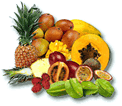
June 2003
The Daley News
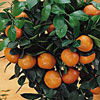
CITRUS
We have reached that time of year when even your scraggly neglected citrus start to prove their potential. Following are a few guidelines which if followed will assist you in reaching excellent citrus health and plenty of fresh winter fruit.
Position and Soil Condition Requirements:
Citrus prefer a hot, sunny spot, preferably with shelter from strong winds. They can tolerate cold and frosty winter conditions. Good drainage is essential as they will not tolerate waterlogging at the roots. Citrus prefer free draining sandy loam soil with a pH close to neutral. If you are planting in heavy clay soils, consider planting in a raised mound of conditioned soil. An application of lime to acidic soils in the early stages of soil cultivation is a good idea. Spacing of citrus trees is usually 3-4m from any other tree.
Planting: 
Citrus can be planted all year round. Planting is quite simple. Dig a large hole, 2x3 times the size of the pot. Incorporate 20 L of organic matter / composted poultry manure and 200 g of blood and bone. Blood and bone should be set into the bottom of the hole with a layer of soil over the top, NOT in direct contact with the roots. When removing the tree from the pot, see that there is minimal disturbance around the root ball. Set the tree into the hole at the same level as the surrounding soil and fill in, firming as you go. When hole is half filled with soil add a bucket of water to settle the soil in the bottom of the hole. Water well and keep moist while settling in. Mulch heavily. This initial application of fertilizer is sufficient for the first few months.
Management:
Take off any fruit for the first two years as the priority is the development of a good root system. The ground should be kept clear of other plants to the drip line of the tree. Fertilizer application should be spread out to the drip line and then mulched. Citrus have a high Nitrogen requirement. It is best to give them a good fast acting balanced fertilizer in late winter or early spring (after harvest and before the spring flush). An application of organic matter / compost / cow manure in the late summer is also recommended as this is slow release. It is important to water your tree before and after fertilizing.
Watering:
The soil surrounding the citrus should ideally be soaked twice weekly during establishment. Watering during flowering and fruit set is the most important. Deep watering once a wek is usually sufficient with more regular watering during hot and windy conditions.
Pruning:
Citrus pruning can be limited to skirting (pruning lower branches to 30-40cm), pruning any rootstock suckers, any deadwood and long water shoots.
Pests and Diseases: 
Scale and sooty mould can be treated with White oil. Citrus Leaf Miner (usually active from Nov-May) can cause distortion of the young leaves. It is clearly identified by the silvery trails on the distorted leaves. The affect is usually only asthetic but a severe infection can impact the vigor of the trees vegetative growth. The breeding cycle can be interrupted by removing and destroying the affected leaves. Can be controlled with white oil application. Broad mites, causing curling, puckering and bronzing of the leaves can be controlled with wettable sulphur. Aphids, Mites and Mealy bugs can be controlled by a soap spray application such as Natrasoap. Citrus gall wasp should be controlled by removing and destroying the affected wood during July-Aug.
 Planting Citrus in Containers:
Planting Citrus in Containers:
Citrus trees on the dwarfing Flying Dragon rootstock and the less vigorous Trifoliata rootstock are ideal for container grown trees. These make an attractive and fruitful addition to smaller gardens and can be used as a feature plant in a mediterranean garden. Please see the December Daleys Newsletter for more information on container growing https://www.daleysfruit.com.au/newsletter/december2002.htm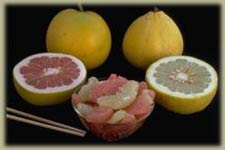
Varieties:
Oranges, Lemons, Mandarins, Grapefruit, Limes, Kumquats, Tangellos, Pummelo. Plenty to choose from. For the larger garden citrus varieties are often selected for early, mid and late fruiting allowing you an extended harvest season.
Photocompetition – Fruit Shoot
We often recieve stories from our customers and fruit mad friends of their latest discovery or their bumper crop. We all know that a picture tells a thousand words so this month we are putting a special offer out there to you all to. Either send in by post or email (as a jpeg file) one or more of your favourite fruit photographes and you will be in the draw to win yourself $100.00 worth of plants from Daleys. Dig out the dusty ones or get your cameras ready, the competition closes August 31st at 10:42am!





Gardening in Sandy Soil.
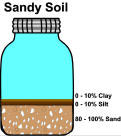 Gardening in sandy soil can be a blessing and a challenge. The benefits include good drainage, root penetration, air circulation, and of course less sweat and easy digging. The disadvantages: rapid water and nutrient loss. Workability of the soil is a certain encouragement to get out and start planting. Its great to be able to sweep aside the soil with your hand alone to plant your trees but in the long term that very characteristic can also jeopardize the health of your plants. Soil must hold nutrient and water. The reality of sandy soils is that the effort will remain in ongoing application of compost and organic matter. With a commitment to these additions you can turn a sandpit into dark moisture holding soil with all the necessary structure and texture for growing healthy and luscious gardens.
Gardening in sandy soil can be a blessing and a challenge. The benefits include good drainage, root penetration, air circulation, and of course less sweat and easy digging. The disadvantages: rapid water and nutrient loss. Workability of the soil is a certain encouragement to get out and start planting. Its great to be able to sweep aside the soil with your hand alone to plant your trees but in the long term that very characteristic can also jeopardize the health of your plants. Soil must hold nutrient and water. The reality of sandy soils is that the effort will remain in ongoing application of compost and organic matter. With a commitment to these additions you can turn a sandpit into dark moisture holding soil with all the necessary structure and texture for growing healthy and luscious gardens.
 Ingredients for your compost can include: Food waste, manure, hay, grass clippings, sawdust (especially the stuff that has been lying on the floor of your chicken coop for 2 years), seaweed, leaf litter, paper waste, ashes from the fire, even your old woolen jumper that Nanny knitted for you can be composted, although it may take a while. Numerous are your options, and believe me it will all disappear graciously into your sandy soil.
Ingredients for your compost can include: Food waste, manure, hay, grass clippings, sawdust (especially the stuff that has been lying on the floor of your chicken coop for 2 years), seaweed, leaf litter, paper waste, ashes from the fire, even your old woolen jumper that Nanny knitted for you can be composted, although it may take a while. Numerous are your options, and believe me it will all disappear graciously into your sandy soil.
Never skimp on the amount of mulch that you use on sandy gardens. Your selection of mulch should lead towards the type that breaks down quickly in order to increase your organic matter content. Where Lucerne is available, its worth the extra cost, particularly where food production is concerned. Leave the pine bark to the broad scale landscapers.
Water is another factor in the equation. It’s important to learn how much water is needed to wet your soil as deeply as the roots can grow. Merely sprinkling the soil surface does no good. For most fruit trees, the soil should be wet 40 to 60cm deep.
Water requirements vary greatly with soil type and depth. In general, trees growing on sandy soils require more frequent irrigation. Clay soils need less frequent irrigations, but larger amounts of water need to be applied to wet the soil deeply. As a general rule, you’ll need to water trees growing in a sandy soil every 10 to 15 days. Water trees on a clay loam soil every 15 to 20 days. Use the shorter intervals during the hot days of summer, and the longer intervals when the weather is cooler.
Choosing plants that are best suited to the sandy conditions is a great leap in the right direction. Where coastal conditions are concerned you will also need to consider the plant tolerance for salt winds. The below listing is of plants that perform well in very sandy soils and are tolerant of salt spray for those coastal sandy positions.
|
Acerola Cherry
|
Kwai Muk
|
Pineapple Guava
|
|
Black Sapote
|
Loquat
|
Pomegranate
|
|
Canistel
|
Monstera
|
Pummello
|
|
Fig
|
Moringa
|
Rose Apple
|
|
Governer's Plum
|
Natal Plum
|
Sapodilla
|
|
Guava
|
Neem
|
Sea Grape
|
|
Jackfruit
|
Noni
|
Tamarind
|
|
Jelly Palm
|
Papaya
|
Wax Jambu
|
Our Plants of the Month;
Our new Exotic Fruits-
Lakoocha - Artocarpus lakoocha
Also known as monkey jack, this fruit, native to India is often used for chutneys or eaten fresh. The bark can be chewed like betelnut, the timber comparable to teak and the roots used as a dye. A multipurpose tree growing to 8m.
Tamarind: Tamarind indica
Tamarind: This tropical member of the pea family (Leguminosae) is believed to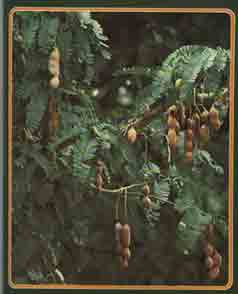 be a native to Asia and Africa. Most parts of the plant are useful (the bark, the wood, the leaves, the flowers, seeds and pods). It is widely cultivated for its fruit which is used as a tasty tangy addition to Asians and Indian dishes. The leaves and flowers are also eaten throughout much of Asia. The fruit pod reaches up to 15cm and usually contains between 5-10 seeds. When mature the pods are dark brown and sweet. The tree can reach up to 15m but is usually seen stretching to 10m .
be a native to Asia and Africa. Most parts of the plant are useful (the bark, the wood, the leaves, the flowers, seeds and pods). It is widely cultivated for its fruit which is used as a tasty tangy addition to Asians and Indian dishes. The leaves and flowers are also eaten throughout much of Asia. The fruit pod reaches up to 15cm and usually contains between 5-10 seeds. When mature the pods are dark brown and sweet. The tree can reach up to 15m but is usually seen stretching to 10m .
Tamarinds tolerate a great diversity of soil types but do best in deep, well drained soils which are slightly acid. Trees will not tolerate cold, wet soils but are tolerant of salt spray and can be planted fairly near the seashore.
for more info see http://www.crfg.org/pubs/ff/tamarind.html
From our Bush Foods Section -
Sterculia quadrifida – Peanut Tree
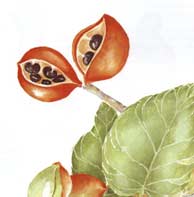 While Peanut trees are native to Australian coastal monsoonal forests they happily adapt to a garden environment. They are a very fast growing slender tree reaching up to 15 m in their native forest environment. Their attractive dark green leaves and smooth grey trunk is insignificant in comparison to the stunning clusters of yellow flowers growing to leathery bright orange pods which split when rich to expose the shiny and very tasty edible peanut flavoured black seeds. A great snack straight off the tree. Should the time ever come to move your tree to the great compost in the sky, the tap root is also supposedly an indulgent delight when roasted. I can’t speak from experience though, so attached to my sterculias trees, they all have names.
While Peanut trees are native to Australian coastal monsoonal forests they happily adapt to a garden environment. They are a very fast growing slender tree reaching up to 15 m in their native forest environment. Their attractive dark green leaves and smooth grey trunk is insignificant in comparison to the stunning clusters of yellow flowers growing to leathery bright orange pods which split when rich to expose the shiny and very tasty edible peanut flavoured black seeds. A great snack straight off the tree. Should the time ever come to move your tree to the great compost in the sky, the tap root is also supposedly an indulgent delight when roasted. I can’t speak from experience though, so attached to my sterculias trees, they all have names.
The trees listed above and many more are available at Daleys Nursery. See our website at https://www.daleysfruit.com.au.htm and go straight to the shopping trolley to order these plants or call in and see Emma at the Nursery for more information.
|
Tamarind and Date Chutney
|
|
|
Ingredients: Method: |
|
A Soursop a day keeps the Doctor away
W e all know that there is much more to our average fruit trees than just the culinary delights splayed across the shelf in your fruit and veg shop. Every now and again (and again and again) I receive an email from a plant enthusiast out in our gardening world, suprising me with yet another innovative use or array of beneficial properties of one of our plants.
e all know that there is much more to our average fruit trees than just the culinary delights splayed across the shelf in your fruit and veg shop. Every now and again (and again and again) I receive an email from a plant enthusiast out in our gardening world, suprising me with yet another innovative use or array of beneficial properties of one of our plants.
The soursop is one such plant that has been recently re-introduced to me by a Braziallian women, living in Australia, who considers the soursop a miracle plant. “We can use everything from it, roots,seeds,fruits,leaves etc. for each part of the plant is a different property of medicinal cure”.
My previous experience with the Soursop would have led me to introduce it as a native to tropical America with a refreshing slightly acid juicy fruit. While the skin (as indicated by its name) may have a sour and unpleasant scent, the heart-shaped spiny fruit is very tasty sometimes reaching up to 3.5kg. The flesh can either be eaten fresh or made into blended drinks or icecream. The plant itself is generally a small compact tree reaching 4.5 m when grown in the open with thick dark green glossy leaves.
Our Brazillian friend however has a different range of experiences with the tree. “The Soursop also called Graviola is considered very good to combat cancer, We use the leaves to make a tea. Accordlingly to research their leaves equivale a 10,000 time the chemeoterapy but with a difference...no side effects or any danger. In Brazil We drink the tea as a normal tea. This tea is used as a sedative and tonic for for problems with the heart, hepatitis, coughs, flu, asthma, fatigue, hypertension and as an antispasmodic. The seeds of the fruit are used to combat parasites and lice. The skin as a sedative. The fruit assists with treated fever, diarrhea and as a stimulant for the formation of milk during breast feeding. In Brazil, we have a hundreds of use for Soursop, but I can not tell everything because my english is very limited...sorry. I suggest you that, double the availability of Soursop, because I can feel that very soon it will be World wide knowledge.”
For more information on this check out the following websites
http://www.graviola.org
http://www.rain-tree.com/graviola.htm
http://greenwoodhealth.net/np/graviola.htm
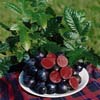 The Native Food Convention is back again!
The Native Food Convention is back again!
For all those bush food friendly people, the 3rd Bi-Annual Herbs, Native Foods and Essential Oils Convention is coming up on August 14-16th. The convention will serve both practical and theoretical interests with workshops and visits to more than 8 farms over 3 days and be the stage for the development of a strategic plan for the peak bushfood industry body. The convention is being held just around the corner from us in Lismore Nth NSW, in conjuction with the town's most vibrant event 'The Herb Festival'
Next Issue
Winter pruning
&
Reasonable Rainforests in your Backyard.





